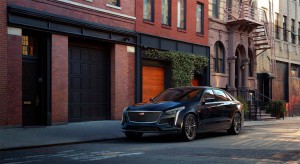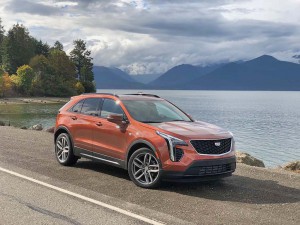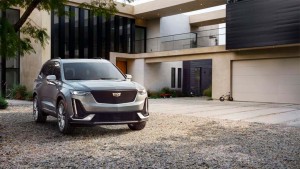The boxes still have to be unpacked, but Cadillac is back from the Big Apple, ending a four-year experiment designed to put the brand more closely in touch with one of the country’s top luxury car markets. Instead, it needs to bring closer together the folks who will both design and then market the wave of new products that will be rolling out over the next decade, brand boss Steve Carlisle said during a Wednesday lunch meeting.
Long billed as the “standard of the world,” Cadillac has slipped well behind key competitors like Mercedes-Benz, BMW and Lexus. But last year’s surge in global sales suggests Caddy may finally be making some of the right moves – beyond last week’s closure of its offices in New York’s tony SoHo neighborhood.
In a broad-ranging discussion, Carlisle outlined both the short and long-term steps Cadillac is taking in its bid to become a truly relevant luxury car player once again. It’s a move that has already begun with a shift in the brand’s product portfolio.
(Cadillac adds to growing portfolio of CUVs with XT5 Sport. Click Here for the story.)
With last year’s launch of the compact XT4 crossover, Cadillac will be rolling out one new product every six months at least into the early part of the coming decade – and likely beyond. The XT4 underscores the brand’s shift to the CUVs that now dominate the U.S. market. A second new model, the XT6, was unveiled at the North American International Auto Show in Detroit in January, with production set to begin later this year.
Also in the works: mid-cycle makeovers of the midsize XT5 and the massive Escalade, both due to debut in the next 12 months.
The crossover strategy appears to be gaining momentum. The XT4 is now the best-seller in its hotly competitive segment, toppling the also-new Acura RDX. With more new product coming, said Carlisle, the brand is expecting a “double-digit” increase in U.S. sales – a much-needed increase considering domestic sales slipped to just 154,702 last year, down from a post-recession peak of 182,543 in 2013.
The massive shift of the U.S. market away from sedans, coupes and convertibles helped scuttle the ambitious product plan laid out by Carlisle’s predecessor, Johan de Nysschen. Production versions of concepts like the Escala were scrapped. And Caddy is culling several existing passenger car models, including the compact ATS and midsize CTS.
That said, the GM luxury division remains “very much committed to sedans,” said Carlisle. Two new four-door models, the compact CT4 and the bigger CT5, are in the works. And, in an unexpected U-turn, the brand has extended the run of the big CT6 flagship that was supposed to end its run with the mid-year closing of the Detroit-Hamtramck Assembly Plant, one of three lines parent General Motors will shutter. The so-called “Poletown” plant will now remain open, and the CT6 continue in production until “at least” January 2020, said Carlisle, adding “we continue to look at alternatives” that could keep the sedan in the line-up beyond that.

The Cadillac CT6 was supposed to be terminated, but lives on until 2020 as the brand determines its direction on sedans.
When Cadillac revealed the new XT6 in Detroit last January, it also offered a sneak peek at another crossover in the works. But this one, which Carlisle said will debut around “2020-ish” will use a new, all-electric drivetrain.
(Click Here for a review of the Cadillac XT4.)
GM CEO Mary Barra last year said the company is on a “path” to going all-electric, though she didn’t lay out a formal timeline. What is clear is that Cadillac will play a lead role, a move many analysts say makes sense because luxury buyers are less concerned about the higher cost of battery drivetrain technology.
Cadillac’s electric SUV will be the first to use an all-new battery-drive architecture, but it won’t be alone for long, Carlisle said, promising a steady stream of battery-electric vehicles, or BEVs, will quickly follow.
“It’s not unlike what we’re doing with (gas-powered products) now, with a new model coming every six months.” Initially, Caddy’s all-electric line-up will “overlap” its gas-powered line-up but those battery-electric vehicles, or BEVs, will begin to replace conventional models “in the middle of the 2020s and accelerate from that.”
The push into electrification will become a critical part of Caddy’s global growth strategy in the coming decade, Carlisle stressed, noting that China is already pushing for a rapid expansion of zero-emissions vehicles, while Europe and Japan are moving in the same direction. Those new models will serve as a “bridge,” he added, helping the automaker grow its presence beyond its two core markets, the U.S. and China.
Cadillac’s bid to become a leader in electric propulsion faces some stiff competition from the likes of Audi, BMW and Mercedes-Benz, as well as Tesla, and could face a crowded market and skeptical buyers. It’s not the only place that Cadillac is pushing the ragged edge of technology, however.
Caddy has become the spearhead of GM’s push into autonomous driving with its Super Cruise system. Capable of operating hands-free for extended periods on limited-access highways, Super Cruise is currently available only on the CT6. Buyers have become increasingly infatuated with the system, the “take rate” almost tripling, to around 50% since the beginning of the year.
(To see more about GM investing in Cadillac’s crossovers, Click Here.)
The goal is to both update and drive down the cost of the system, said Carlisle, putting it in reach of more buyers. The new XT6 will be next to add Super Cruise to its list of options, with Caddy planning to roll it out on “all” new models, “starting in 2020.”


